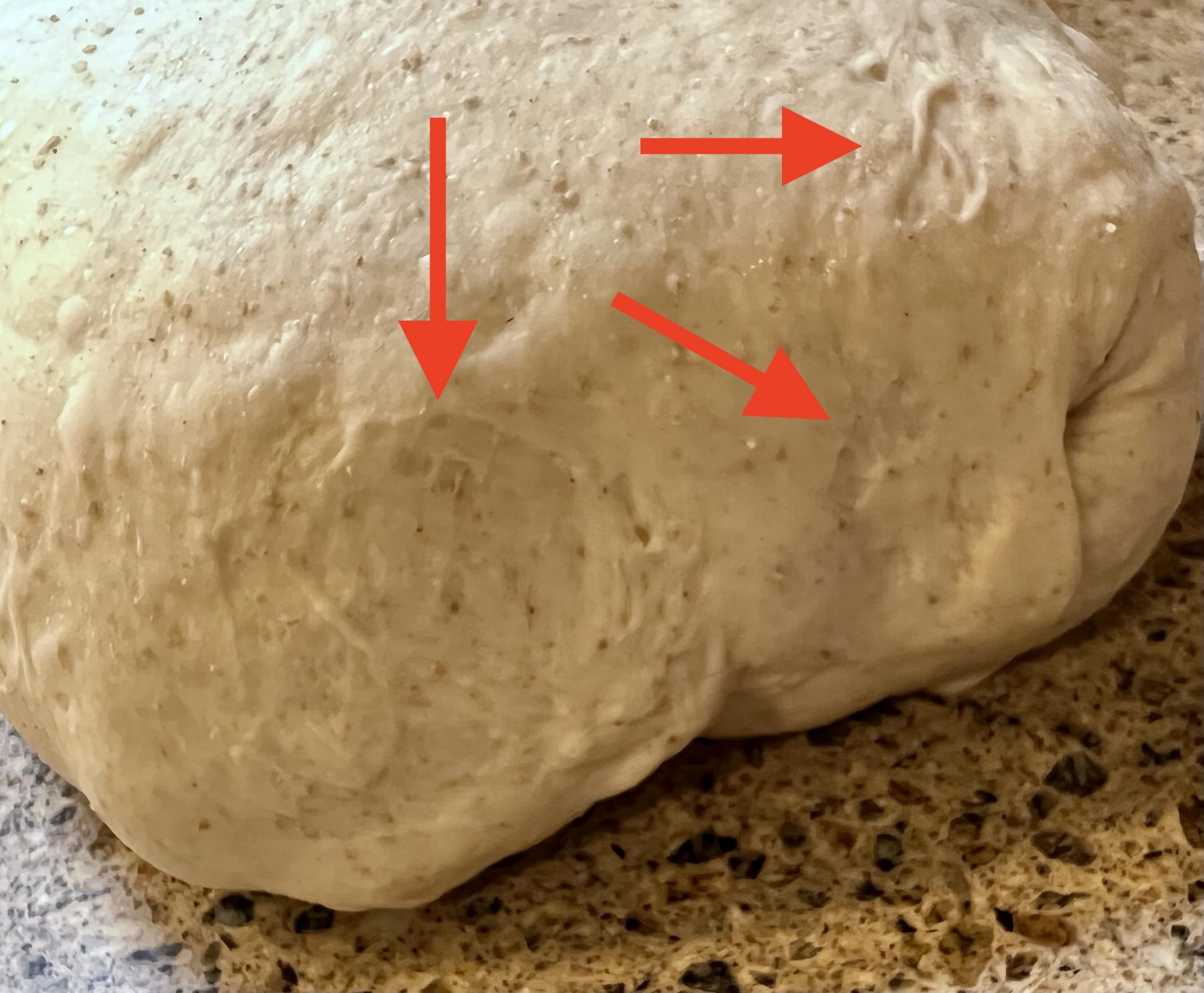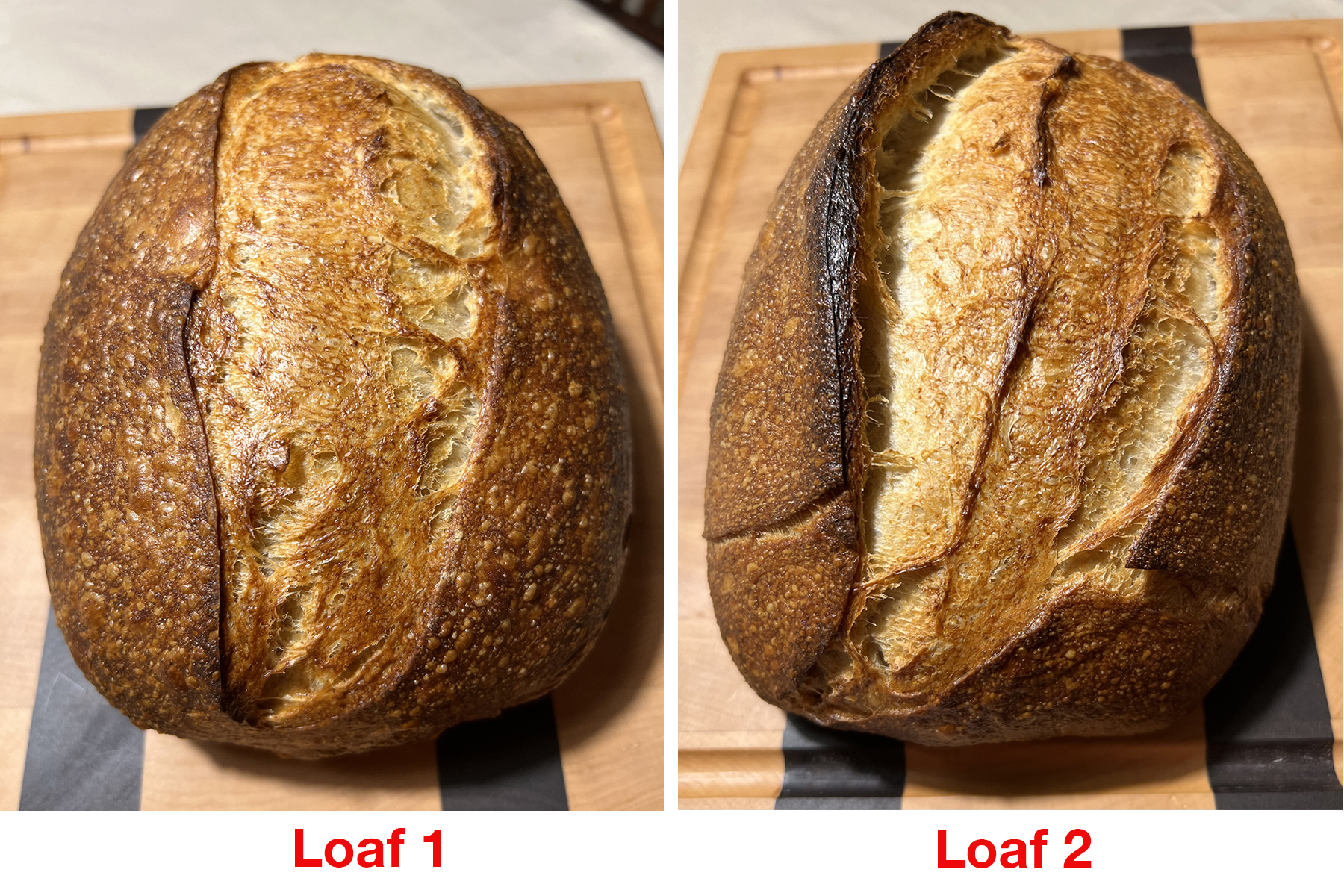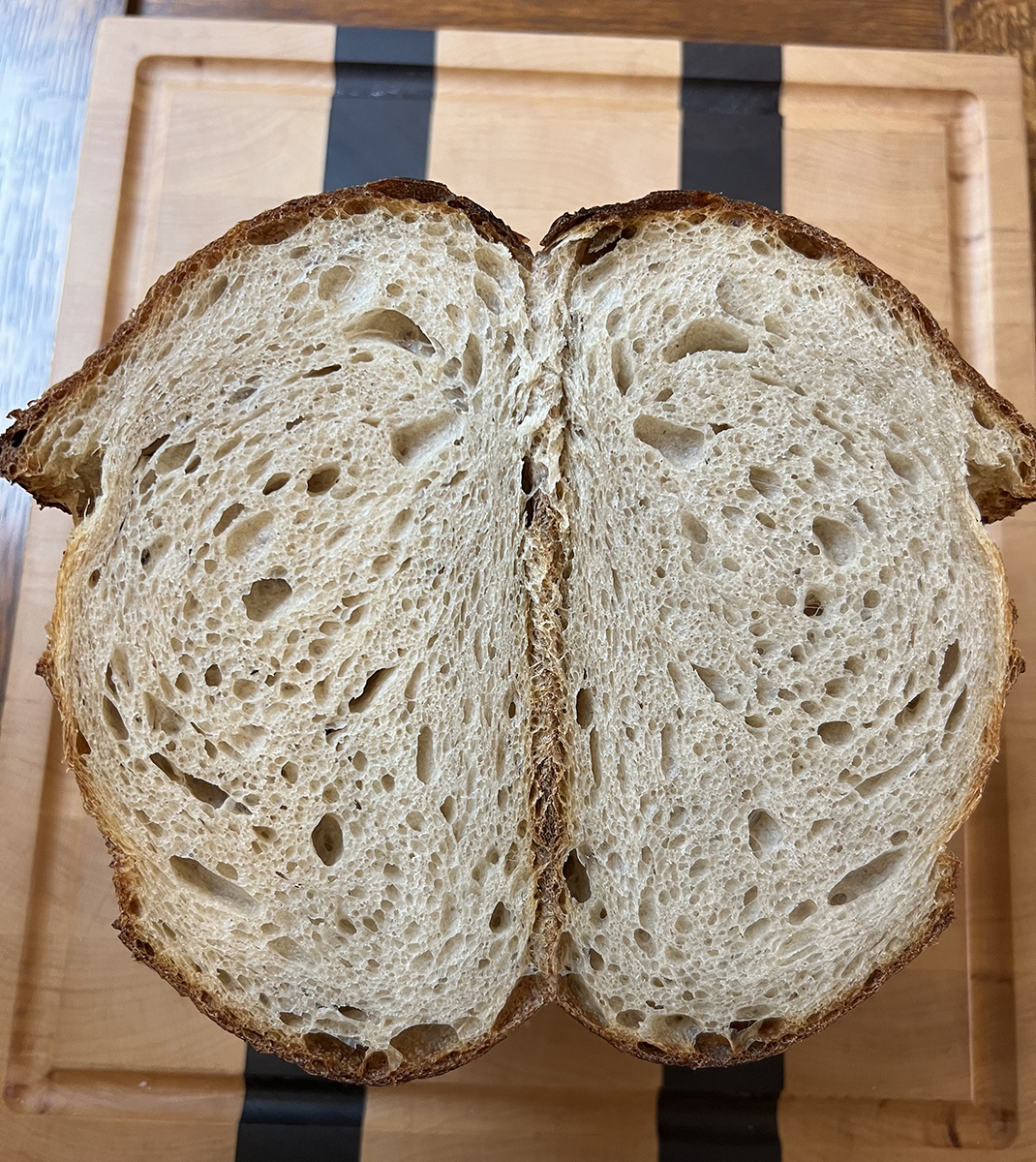BACKGROUND
My husband is not a fan of sourdough, although everyone else in my family loves the stuff. He won’t eat any bread if he detects the merest hint of sourdough flavor. When I happened upon Swiss Farmhouse Bread in Jeffrey Hamelman’s Bread, which in Mr Hamelman’s words is characterized by “a complete absence of acidity,” I was curious. The bread was leavened by water in which yeasty raisins had been soaking and that was my entree into the world of yeast water. Working with YW made me wonder if it could be used in conventional sourdough breads and what its effects might be. Wouldn’t it be nice if a flavor profile emerged that could be a favorite (if not the favorite) of all the people I bake for? Hey, a girl can dream, can’t she?
YW is interesting to me as a potential means to that end, but two things about it concern me:
1) The Swiss Farmhouse crumb was a little bland without the flavor enhancement provided by fruit and nuts. I’m searching for something other than the familiar sourdough flavor profiles, but I would still like a flavorful bread.
2) I’ve found the rise times of YW to be wildly unpredictable, which makes me hesitant to use it except when I happen to have a few days when nothing else is planned. Once my YW matures and I get in the habit of keeping YW levains under refrigeration for later use, I hope this will change.
It seemed reasonable to start this project with my basic SD bake, Vermont Sourdough (also a Hamelman formula). After again checking with the YW gurus here on TFL, it was pretty clear that every baker has their own way of incorporating YW into conventional SD loaves and that pretty much any of them could be expected to work.
PROCESS
Yeast Water
The first order of business was to give the YW some TLC. It was removed from the refrigerator the day before the bake and the liquid poured off into a clean jar. I was careful to pour off as little of the bottom sludge as possible, which I understood might contain a fair percentage of dead yeasts that could add glutathione to the dough, an eventuality I wished to avoid. There seems to be some anecdotal evidence contradicting that outcome, but I didn’t see any point in taking the risk, so I declared the new jar a Sludge-Free Zone. Diced organic apple was added to the jar and the pH was measured. It tested at 3.73 despite the fact that it had been holding steady at 3.43 – 3.46 for its first three weeks of life. The jump to 3.73 seemed like a large-ish decrease in acidity that I was unable to account for. As long as the pH was below 4.0, I believed it was safe to use, but it seemed to be headed in the wrong direction, so I dropped in the teeny-tiniest pinch of Ascorbic acid (probably about a tenth or two of a gram) and left those little yeasties alone to do their overnight thing. Since the YW was increasingly sluggish the last couple bakes, I hoped these measures would yield a yeastier, more active YW.
Preferments
Based on input from several TFL members and my own wish to use the same amount of prefermented flour called for in the original formula, I decided to make two half-size levains, the first half a standard SD and the second half made from YW. The SD levain for this bread is a liquid levain of 120% hydration. My preference was not to change the hydration, but I remembered reading an assertion that YW levains are better on the stiff side, so at the last second I decided to make the YW levain at 70% hydration to match the final dough. The final dough water was adjusted to accommodate this change. For the record, bottled mineral water was used in the final dough. I usually use filtered tap water.
I decided to build both levains just before bedtime and hope that the SD levain didn't mature first. Fortunately they seemed to track reasonably well and both levains were ready for use around the same time. The SD had receded only very slightly from its peak when it was mixed into the dough.
Final Dough
The autolyse was mixed in my Ankarsrum on the lowest speed because I intended to do the final mix that way, so why not. The Ank is very gentle on low settings. The dough was still surprisingly ragged 30 minutes into the autolyse, but had improved by the 45 minute mark. It had an unusual feel to it, but I proceeded with the mix and that’s when things got really weird. I’m hard-pressed to describe the dough’s texture. It felt soft but… I don’t know… dry? tight? Those aren’t the right descriptors, but they’re the best ones I can come up with. I added 10-15g water in small increments in the hope of improving the texture. The additional water helped the dough feel somewhat better, but it did not feel like the gluten was developing well at all. The surface of the dough was beginning to appear pock-marked and after 7 minutes of mixing about 3/4 of the way up the Ankarsrum dial (the sixth “box”), the surface of the dough started pulling and breaking. I have not encountered this before and wondered if it might be the affect of glutathione. I have no familiarity with it and don’t know.
The Jiffy Pop Moment
Instinctively, I pulled the dough from the mixer bowl. It was quite sticky but not unmanageable with wet hands. I folded the dough but that just made it tear. I don’t know why I thought to try French folds when regular folds didn’t work, but for some reason they did seem to have a positive effect – until they didn't. Just when I was about to stop, the top surface of the dough split open like Jiffy Pop revealing layers of folded dough inside. I wish I’d thought to photograph it but in the moment my only thoughts were geared toward salvaging the dough if possible. I quickly folded the hole closed and did another FF. It seemed alright, so I did another and then another until the dough was largely smoothed out. Not wanting to bring on the Jiffy Pop Effect again, I stopped the moment most of dough’s surface looked smooth. I’d guesstimate there were about 40 or 50 FFs in total.


Mostly smooth, but there are still pock marks along the edges. I do wish I had photographed the dough at its worst, but honestly, there was work to be done.
At the end of the mix, the dough temp was 76.3°F so at least that was on target, even if nothing else was.
Bulk Fermentation
The dough was slightly risen after 90 minutes. It was more extensible after resting but still prone to tearing so there was no stretching, only folding. Pock marks like the ones in the photos above were apparent where the dough folded. Afterwards, the dough continued to rise but felt dense and heavy. Even when it had doubled in volume, it looked and felt leaden. I don’t typically let my doughs double during bulk and, under the circumstances, I was afraid of degradation so I shaped the loaves. Maybe I should have done so sooner. Too many mixed signals to be sure of anything.
Shape & Bake
After a preshape and 15 minute bench rest, the dough was molded more so than folded into shape to avoid tearing. The final proof progressed quickly and looked sufficiently risen after about 60 minutes. On feeling the dough, it still lacked that certain lightness that tells you it’s ready, so I let it go another 20 minutes until one of the loaves felt acceptably aerated. I was still concerned about gluten degradation, so that loaf was sprayed with water and, since it seemed sturdy despite its propensity for pulling and tearing, I scored it but only very shallowly. It stood up well to the slash. The dough was loaded into the preheated Fourneau Grande and the hatch closed. Silent prayers were said.
When Loaf #1 emerged from the oven, it exhibited great oven spring and a nice blistered crust. There was no ear; the dough filled in the bloom area and leveled out. I thought this was most likely due to the shallow scoring, so I focused on making a deeper cut into the second loaf. Unfortunately, I didn’t angle the blade very much. Who in that situation can resist the urge to commit the cardinal sin of re-scoring even though you know its impossible to hit the exact same spot? Not me. The result is the second loaf has a somewhat better ear and bloom but bears the scars of botched surgery.
Grand Opening
I'm going to bury the lede here and begin by saying the flavor was good, and the best part was that my husband enjoyed it. That was a win right there. Unfortunately, the crumb was a different story. Despite the good oven spring, the loaf was verrry heavy – not unexpected given the dough quality. You know that old trick question about which weighs more, a ton a feathers or a ton of bricks? The correct answer is a pound of this bread.
The bread looks better in the photos below than it turned out to be in real life. At the same, it wasn’t terrible. Given the bizarre dough quality, I was not expecting an edible bread. And, truthfully, the eating quality is not great… but it’s not bad either and makes, like many substandard loaves, decent toast.


ANALYSIS – NO ANSWERS, ONLY QUESTIONS
So what happened with this dough? I assume the fault was floating in my jar of YW, so I made a fresh batch inoculated by a spoonful drawn from the old jar. This is the first time in the 4 weeks since it was first made that the water was completely changed. I feared doing so might dilute the yeast population in a young culture, but in light of the poor dough development, it seemed the prudent thing to do. The new YW spent the night in the proofer at the low setting of 75°F (the overnight temp inside the box was probably closer to 70°F). Once it looks active and the pH dips below 4.0, it will be refrigerated and given a few more days to develop.
Meanwhile, another YW levain (second build) rests in the refrigerator. I mixed extra to have on hand for SD-YW Test Bake #2, but now I think I will toss it and make a new levain when the new YW is ready.
TO BE CONTINUED